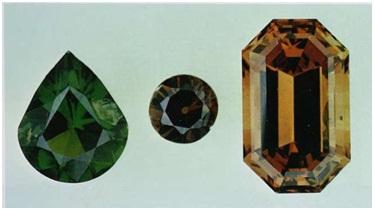Enstatite Value, Price, and Jewelry Information
Most gem enstatites have indices in the range 1.663-1.673. The brown and green gems from Tanzania are enstatites, as are the brownish-green stones from Sri Lanka. Green and brown gems from India and Brazil tend to be in the bronzite composition range. The gems of the orthopyroxene series are usually very dark, slightly brittle because of cleavage, and generally not appealing for jewelry purposes. The 4-rayed star gems are widely sold at a very low price, and the material is extremely plentiful. However, clean gems of hypersthene and enstatite are not abundant, except in very small (1-2 carat) sizes. Even in this size the colors tend to be dark and muddy. These are all true collector gemstones. Orthoferrosilite is included for completeness and has no gem significance.
2 Minute Read
Start an IGS Membership today
for full access to our price guide (updated monthly).Enstatite Price
Highest values go to transparency, colorless, then size. In cabochons, asterism.
Orthopyroxene Group: Bronzite; Hypersthene; Ferrohypersthene; Eulite; Orthoferrosilite.
Composition
This is a complex solid-solution series involving Fe and Mg silicates. The series extends from enstatite: MgSiO3, through bronzite: (Mg,Fe)SiO3, hypersthene(Fe,Mg)SiO3, to Orthoferrosilite FeSiO3. Like the plagioclase feldspars, the series is arbitrarily broken into six regions of composition (numbers refer to percentage of orthoferrosilite molecule in formula):
Optic Sign
The optic sign changes along the series, from (+) to (-) and back to (+). The break points are at 12% and 88% orthoferrosilite:
Occurrence
Mg-rich members of the series are common in basic and ultrabasic rocks; also in layered intrusions; volcanic rocks: high-grade metamorphic rocks; regionally metamorphosed rocks and hornfels; meteorites.
Gem enstatite occurs in Burma, Tanzania, and Arizona. Also noted from Mairimba Hill, Kenya (yellowish green; a = 1.652; γ= 1.662; birefringence = 0.010; S.G. = 3.23). Other noteworthy localities are Norway, California, and Germany.
- India produces 4-rayed star enstatites.
- Rare green gems come from Kimberley, South Africa.
- Bronzite comes from Mysore, India, and Styria, Austria: 6-rayed bronzite stars have been found.
- Hypersthene is noted from Norwa, Greenland, Germany and California, with gem material from Baja California, Mexico.
- Bastite is an altered enstatite (S.G. = 2.6, hardness = 3.5-4, opaque) from which cabochons are cut. Localities: Burma and Harz Mountains, Germany.
- Embilipitiya, Sri Lanka: colorless enstatite (cut gems up to ≈ 20 carats!) with R.1. = 1.658-1.668; birefringence = 0.010; S.G. = 3.25; quartz inclusions.
- Ratnapura, Sri Lanka: green and brown enstatite with R.I. = 1.665-1.675; birefringence = 0.010; S.G. = 3.23.
Comments
Most gem enstatites have indices in the range 1.663-1.673. The brown and green gems from Tanzania are enstatites, as are the brownish-green stones from Sri Lanka. Green and brown gems from India and Brazil tend to be in the bronzite composition range. The gems of the orthopyroxene series are usually very dark, slightly brittle because of cleavage, and generally not appealing for jewelry purposes. The 4-rayed star gems are widely sold at a very low price, and the material is extremely plentiful. However, clean gems of hypersthene and enstatite are not abundant, except in very small (1-2 carat) sizes. Even in this size the colors tend to be dark and muddy. These are all true collector gemstones. Orthoferrosilite is included for completeness and has no gem significance.
| Enstatite | Bronzite | Hypersthene | Orthoferrosilite | |
| Specific Gravity | 3.20-3.30 | 3.30 -3.42 | 3.43 - 3.90 | 3.90 - 3.96 |
| Optics | ||||
| a | 1.650-1.655 | 1.665 - 1.686 | 1.686-1.755 | 1.755 -1.768 |
| β | 1.653-1.671 | (intermediate) | 1.763-1.770 | |
| γ | 1.658-1.680 | 1.680-1.703 | 1.703 -1.772 | 1.772-1.788 |
| sign | (+) | (-) | (-)(+) | (+) |
| Birefringence | 0.010 | 0.015 | 0.017 | 0.018 |
Names
Enstatite from the Greek for an opponent because of its high melting point. Bronzite is named for its bronzy color and luster. Hypersthene is from the Greek words for very strong or tough. Orthoferrosilite is named for its crystallography and composition. Bastite is also named for its composition: Ba, Si, Ti.
Variety Names
Bronzite, brown color with fibrous inclusions giving it a bronze appearance.
Joel E. Arem, Ph.D., FGA
Dr. Joel E. Arem has more than 60 years of experience in the world of gems and minerals. After obtaining his Ph.D. in Mineralogy from Harvard University, he has published numerous books that are still among the most widely used references and guidebooks on crystals, gems and minerals in the world.
Co-founder and President of numerous organizations, Dr. Arem has enjoyed a lifelong career in mineralogy and gemology. He has been a Smithsonian scientist and Curator, a consultant to many well-known companies and institutions, and a prolific author and speaker. Although his main activities have been as a gem cutter and dealer, his focus has always been education. joelarem.com
Related Articles
Black Diamond Value, Price, and Jewelry Information
Chameleon Diamond Value, Price, and Jewelry Information
Gray Diamond Value, Price, and Jewelry Information
Green Diamond Value, Price, and Jewelry Information
Latest Articles
Milarite Value, Price, and Jewelry Information
Appraising Pearls: How to Grade Pearls
Agate Buying Guide
Carving Techniques for Handling Inclusions in Transparent Gems
Never Stop Learning
When you join the IGS community, you get trusted diamond & gemstone information when you need it.
Get Gemology Insights
Get started with the International Gem Society’s free guide to gemstone identification. Join our weekly newsletter & get a free copy of the Gem ID Checklist!
